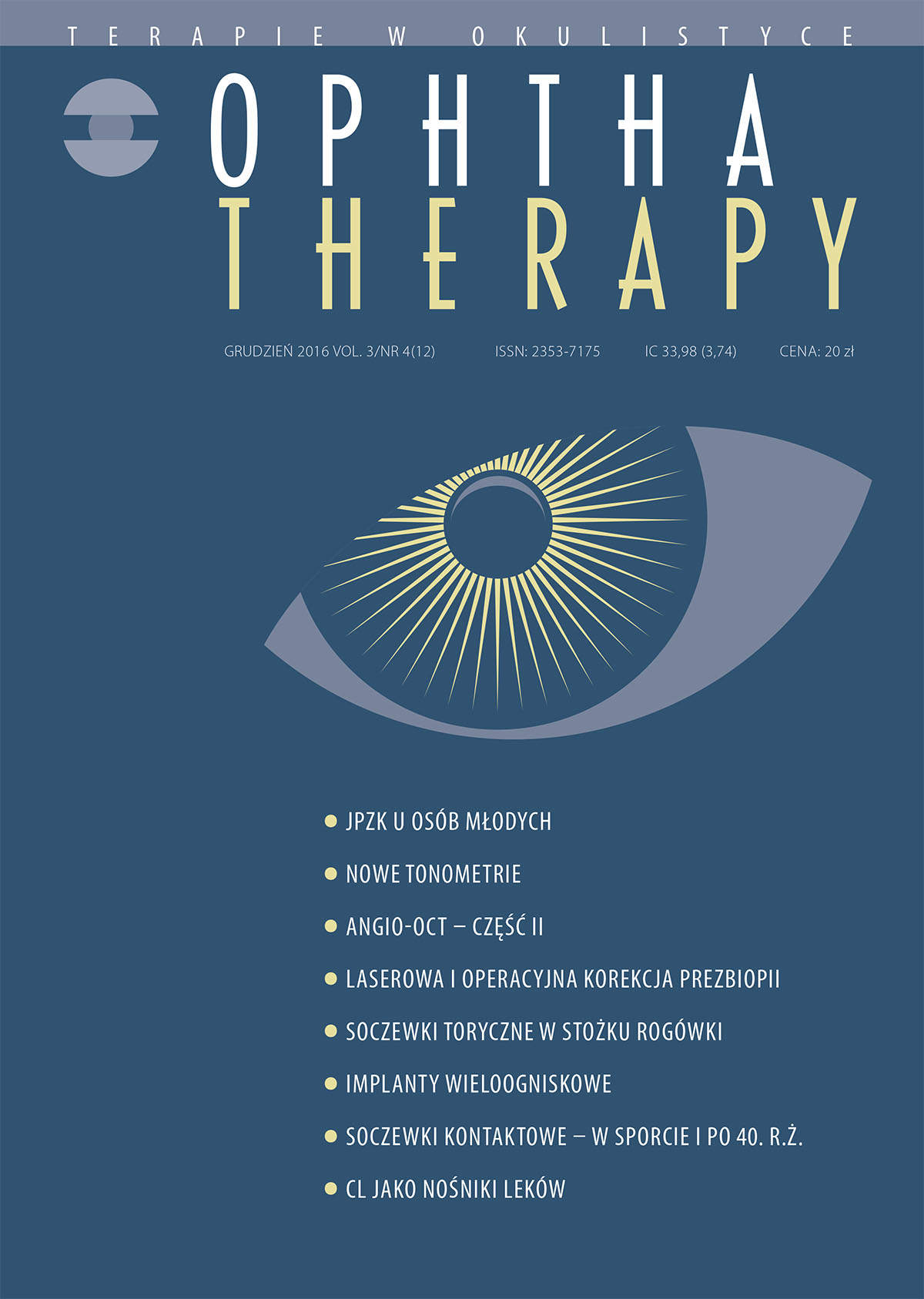Procedury laserowe w korekcji starczowzroczności
##plugins.themes.bootstrap3.article.main##
Abstrakt
W artykule dokonano przeglądu zarejestrowanych platform używanych w leczeniu starczowzroczności. Szczególną uwagę poświęcono monowizji, będącej obecnie najbardziej popularną laserową metodą korekcji tej dolegliwości. Przedstawiono jej ograniczenia i kryteria kwalifikacji pacjentów, zwracając uwagę na rolę dominacji ocznej. Podkreślono różnicę między tradycyjną monowizją a zabiegami mikromonowizji (LBV, laser blended vision). Opisano także aktualne protokoły ablacji wieloogniskowej i ich ograniczenia. Przedstawiono wyniki i profil bezpieczeństwa laserowych metod korekcji starczowzroczności.
Pobrania
##plugins.themes.bootstrap3.article.details##

Utwór dostępny jest na licencji Creative Commons Uznanie autorstwa – Użycie niekomercyjne – Bez utworów zależnych 4.0 Międzynarodowe.
Copyright: © Medical Education sp. z o.o. License allowing third parties to copy and redistribute the material in any medium or format and to remix, transform, and build upon the material, provided the original work is properly cited and states its license.
Address reprint requests to: Medical Education, Marcin Kuźma (marcin.kuzma@mededu.pl)
Bibliografia
2. Croft MA, Glasser A, Kaufman PL. Accommodation and presbyopia. Int Ophthalmol Clin. 2001; 41(2): 33-46.
3. WHO. Vision 2020. Global initiative for the elimination of avoidable blindness. Fact Sheet No 1213. WHO, Geneva 2000.
4. Pallikaris IG, Papatzanaki ME, Stathi EZN et al. Laser in situ keratomileusis. Lasers Surg Med. 1990; 10: 463-68.
5. Seiler T, Bende T, Wollensak J et al. Excimer laser keratectomy for correction of astigmatism. Am J Ophthalmol. 1988; 105: 117-24.
6. Moreira H, Garbus JJ, Fasano A et al. Multifocal corneal topographic changes with excimer laser photorefractive keratectomy. Arch Ophthalmol. 1992; 110: 994-9.
7. Vinciguerra P, Nizzola GM, Bailo G et al. Excimer laser photorefractive keratectomy for presbyopia: 24-month follow-up in three eyes. J Refract Surg. 1998; 14: 31-7.
8. Goldberg DB. Comparison of myopes and hyperopes after laser in situ keratomileusis monovision. J Cataract Refract Surg. 2003; 29: 1695-701.
9. Schor C, Landsman L, Erickson P. Ocular dominance and the interocular supperession of blur in monovision. Am J Optom Physiol Opt. 1987; 64: 723-30.
10. Handa T, Mukuno K, Uozato H et al. Ocular dominance and patient satisfaction after monovision induced by intraocular lens implantation. J Cataract Refract Surg. 2004; 30(4): 769-74.
11. Miranda D, Krueger RR. Monovision laser in situ keratomileusis for pre-presbyopic and presbyopic patients. J Refract Surg. 2004; 20: 325-8.
12. Sippel KC, Jain S, Azar DT. Monovision achieved with excimer laser refractive surgery. Int Ophthalmol Clin. 2001; 41(2): 91-101.
13. Braun EH, Lee J, Steinert RF. Monovision in LASIK. Ophthalmology. 2008; 115: 1196-202.
14. Zhang F, Sugar A, Arbisser L et al. Crossed versus conventional pseudophakic monovision: Patient satisfaction, visual function, and spectacle independence. J Cataract Refract Surg. 2015; 41: 1845-54.
15. Reinstein DZ, Archer TJ, Gobbe M. LASIK for myopic astigmatism and presbyopia using nonlinear aspheric micro-monovision with the carl zeiss meditec MEL 80 Platform. J Refract Surg. 2011; 27: 23-37.
16. Reinstein DZ, Carp GI, Archer TJ et al. LASIK for the correction of presbyopia in emmetropic patients using aspheric ablation profiles and a micro-monovision protocol with the Carl Zeiss Meditec MEL80 and VisuMax. J Refract Surg. 2012; 28(8): 531-41.
17. Reinstein DZ, Archer TJ, Gobbe M. Aspheric ablation profile for presbyopic corneal treatment using the MEL80 and CRS Master Laser Blended Vision module. J Emmetropia. 2011; 2(3): 161-75.
18. Reinstein DZ, Morral M, Gobbe M et al. Accuracy of refractive outcomes in myopic and hyperopic laser in situ keratomileusis: Manifest versus aberrometric refraction. J Cataract Refract Surg. 2012; 38(11): 1989-95.
19. Reinstein DZ, Carp GI, Archer TJ et al. LASIK for hyperopic astigmatism and presbyopia using non-linear aspheric micro-monovision with the Carl Zeiss Meditec MEL 80 platform. J Refract Surg. 2009; 25(1): 37-58.
20. Reinstein DZ, Carp GI, Archer TJ et al. LASIK for presbyopia correction in emmetropic patients using non-linear aspheric micro-monovision with the Carl Zeiss Meditec MEL 80 platform. J Refract Surg. 2012; 28(8): 531-41.
21. Jung SW, Kim MJ, Park SH et al. Multifocal corneal ablation for hyperopic presbyopes. J Refract Surg. 2008; 24: 903-10.
22. Iribarne Y, Juarez E, Orbegoz J. Bi-aspheric ablation profile for presbyopic hyperopic corneal treatments using AMARIS with PresbyMAX module: Multicentric Study in Spain. J Emmetropia. 2012; 3: 5-16.
23. Uthoff D, Peolzl M, Hepper D et al. A new method of cornea modulation with excimer laser for simultaneous correction of presbyopia and ametropia. Graefes Arch Clin Exp Ophthalmol. 2012; 250: 1649-61.
24. Alio JL, Chaubard JJ, Caliz A et al. Correction of presbyopia by Technovision central multifocal LASIK (presby LASIK). J Refract Surg. 2006; 22: 453-60.
25. Uy E, Go R. Pseudoaccommodative Cornea Treatment Using the NIDEK EC-5000 CXIII Excimer Laser in Myopic and Hyperopic Presbyopes. J Refract Surg. 2009; 25(supl. 1): S148-55.
26. Ryan A, O’Keefe M. Corneal approach to hyperopic presbyopia treatment: Six-month outcomes of a new multifocal excimer laser in situ keratomileusis procedure. J Cataract Refract Surg. 2013; 39: 1226-33.
27. Saib N, Abrieu-Lacaille M, Berguiga M et al. Central PresbyLASIK for Hyperopia and Presbyopia Using Micro monovision With the Technolas 217P Platform and SUPRACOR Algorithm. J Refract Surg. 2015; 31(8): 540-6.
28. Holzer MP, Mannsfeld A, Ehmer A et al. Early outcomes of INTRACOR femtosecond laser treatment for presbyopia. J Refract Surg. 2009; 25: 855-61.
29. Menassa N, Fitting A, Auffarth GU et al. Visual outcomes and corneal changes after intrastromal femtosecond laser correction of presbyopia. J Cataract Refract Surg. 2012; 38: 765-73.
30. Goldberg DB. Computer-animated model of accommodation and presbyopia. J Cataract Refract Surg. 2015; 41: 437-45.
31. Yoo A, Kim JY, Kim MJ et al. Hydrogel Inlay for Presbyopia: Objective and Subjective Visual Outcomes. J Refract Surg. 2015; 31(7): 454-60.
32. Whitman J, Hovanesian J, Steinert RF et al. Through-focus performance with a corneal shape-changing inlay: One-year results. J Cataract Refract Surg. 2016; 42: 965-71.
33. Jacobs S. Presbyopic Allogenic Refractive Lenticule (PEARL). [Materiał konferencyjny] Innovative Session ESCRS, Copenhagen 10–14.09.2016.
34. Mrochen M. Allogenic corneal onlays and inlays. [Materiał konferencyjny] Free Paper Session ESCRS, Copenhagen 10–14.09.2016.

